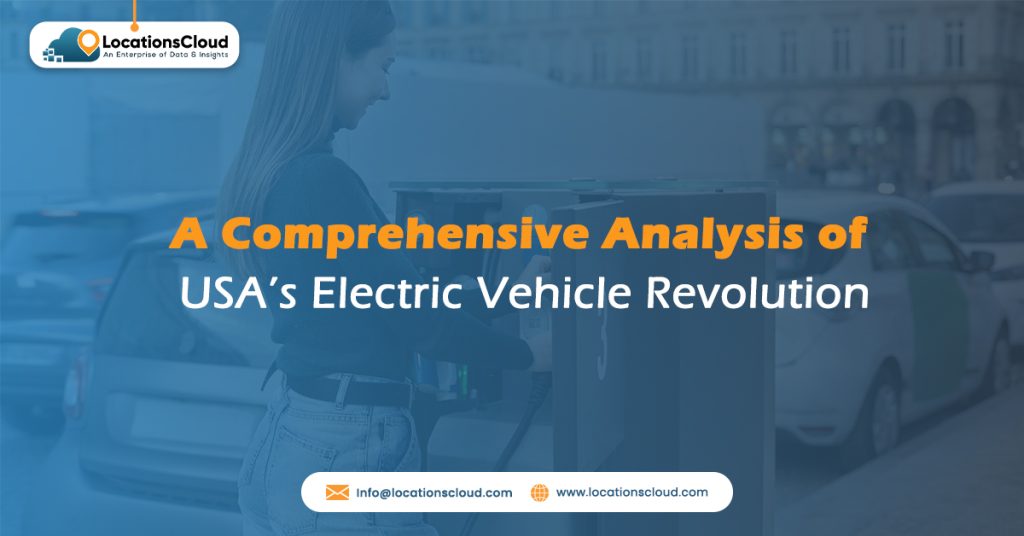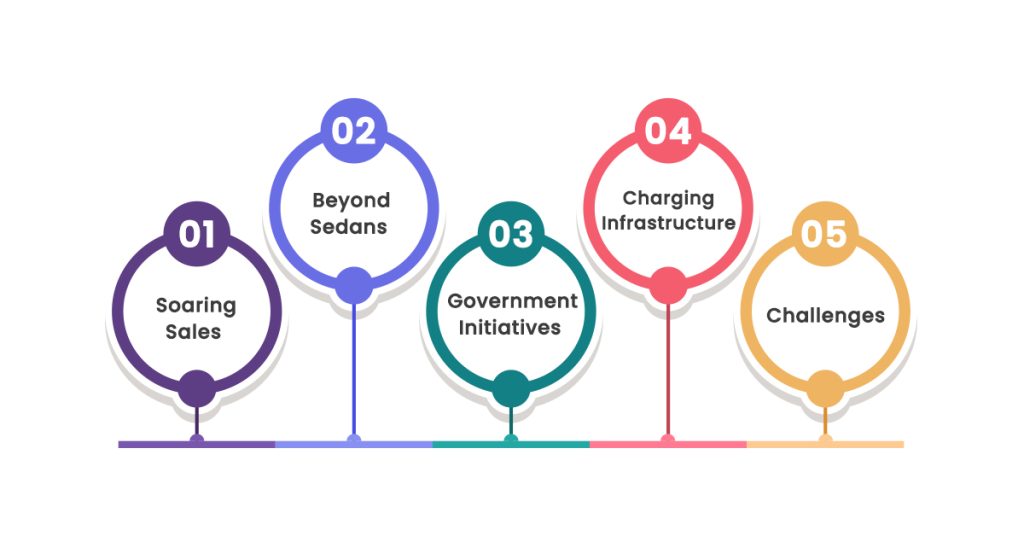
The electrification of the auto industry has sparked a revolution, setting new standards for green transportation. Ever wondered about the sensational surge of Electric Vehicles (EVs) on U.S. roads lately? But beyond the hype, what’s going on, and how will it change how we travel? As the buzz around EVs is louder than ever before, let’s navigate the turns of this rapidly evolving landscape in this comprehensive blog. So, whether you’re an EV enthusiast, a keen investor, a curious environmentalist, or simply someone who loves to stay atop the latest trends, we’ve got exciting insights for you all.
Electric Vehicle Market in the United States (US)
Electric vehicles are a revolution on wheels, and various reasons like rising gas prices, government incentives, and an eco-conscious shift fuel the surge in the US. With trucks and SUVs joining the EV party, there is an impeccable shift in battery charging infrastructure. There was an unbelievable surge in volume of 48% in Q2 in 2023, with over 300,000 EV cars rolled out. By 2028, the market is expected to grow to a whopping 7 billion. With incentives like the Inflation Reduction Act by the government, the future of Electric vehicles the USA is electrifying.
In the US Electric Vehicle Market, SUVs account for 60% of total EV sales, cementing their status as a prevalent option. The Electric Vehicle market is on a steady rise, propelled by tech developments and consumer interest. While the actual figures may fluctuate, the growth trend is undeniably exponential.
EV Market Trend in the U.S

The US electric vehicle market is roaring, leaving gas stations in the dust. Here are some of the note-worthy EV market trends in the US that are shaping the industry.
Soaring Sales
In 2023, electric vehicle (EV) in the US sales increased two times compared to 2022, with more than 600,000 EVs sold. This growth is likely to continue, with an estimated 1 million EVs sold in 2024 and as many as 5 million by 2030.
Beyond Sedans
It’s not just sleek sedans anymore. Trucks and SUVs are increasingly embracing the electric revolution. Ford’s F-150 Lightning and Rivian’s R1T are leading the charge, proving that EVs can be powerful and practical too. This significant shift opens up the EV market to a much wider segment of American consumers who value utility and performance.
Government Initiatives
The government encourages more people to use electric vehicles (EVs) by offering tax advantages and cashback. This support helps make EVs more affordable for average Americans, as they usually cost more than traditional fuel cars. The Inflation Reduction Act stands out, highlighting the government’s commitment to promoting environmentally friendly transportation and its belief in the progress of electric vehicles.
Charging Infrastructure
People used to worry a lot about how far electric vehicles (EVs) could travel before needing a charge, which slowed their adoption. However, that situation quickly evolves as more charging points pop up nationwide. Tesla is growing its Supercharger network, and numerous other firms are seriously investing in developing their charging facilities.
Challenges
Although incentives help, EVs still have a higher upfront cost than gas-powered vehicles. Establishing a robust nationwide charging network requires time and resources. While progress is being made, there are still areas with limited options.
Future of Electric Vehicles in the USA
The prospects for US electric vehicle market is sparkling metaphorically and physically. It is estimated that, by 2032, EVs may account for 67% of new automobile sales. With the technological advancements, concerns about cost and travel distance are expected to be resolved. With the evolving EV market trends in US, the growth opportunities are endless.
Not just that, the roars of gasoline engines is being replaced by the silent hums of electric motors. Much cleaner air and less dependency on foreign energy sources means a more secure future for America. As the electric vehicle market in the U.S. is booming, there is a lot of scope for creating new jobs and exciting entrepreneurial opportunities.
Geography of the EV Market in the USA

The US electric vehicle market is not confined to rich areas anymore, the market is expanding nationwide and to different regions at a varying speed. Here are a few insights on the EV market growth in the United States.
West Coast
West Coast is leading the charge as an undisputed EV champion with over 40% of new electric car sales. Fueled by state incentives, strong charging infrastructure, and tech-savvy and environmentally conscious consumers, California is boasting the electric revolution. Silicon Valley’s innovative startups and tech giants, followed by Washington, Oregon, Portland, and Seattle, are emerging as EV hubs.
Sunbelt
With the increasing awareness of air quality, rising gas prices, and government initiatives, seatbelt areas like Arizona, Florida, and Texas are emerging as contenders. With the growing population, Texas is an example of shifting energy priorities, with Miami and Atlanta already becoming hotspots.
Central Region
Though states like Illinois and Michigan are known as automotive powerhouses and EV production, they do lack in adoption. Major automakers like Ford and General Motors are investing in electric production, revitalizing these traditional car hubs. Rural areas face challenges like affordability and limited infrastructure.
Northeast Region
Being an environmentally aware state Massachusetts is leading in the northern region. Densely populated urban states like New York, New Jersey, and Boston have seen strong interest in EVs due to the growth in charging infrastructure. However, the parking fee and cost are still the challenges that need to be overcome.
The geography of the US EV market is constantly evolving, with regional dynamics shaping adoption trends. California remains the leader, but other regions are quickly catching up. As infrastructure expands and policies evolve, government and automobile giants are making electric vehicles accessible to everyone, from coast to coast.
Comprehensive Charging Infrastructure in US
The extensive network of electric vehicle (EV) charging stations in the US is equipped with tools such as Open Charge Map, NERL, Department of Energy and PlugShare. These comprehensive EV location datasets provide real-time availability and detailed specs on every type of charging plug. This information helps you with range anxiety by identifying fast charging stations for long-distance travelers, easy-to-use chargers nearby, and places to charge your car in offbeat or rural areas.
These EV charging station location databases are not only useful for travelers but also shed light on opportunities to sell electric vehicles, dealership opportunities, and even user reviews, which aid in investment choices and strategic planning.
Major Players in U.S. Electric Vehicle Market
The electric vehicle market is evolving rapidly, and it is fueled by many ambitious players. Here are some of the major companies that are contributing to the EV market growth in the United States.
- Propelled by innovation, Tesla has been at the forefront, capturing 40% of the E.V. market share in 2023 with its sleek and high-performing models like Model S and Model 3.
- General Motors is a traditional giant reclaiming its share in the market with a diverse lineup of electric vehicles including Chevrolet Bolt and GMC Hummer EV. With an extensive dealership network and robust infrastructure GM is poised to lead the market in coming years.
- Ford, an iconic automaker in America is revolutionising with a market share of 14% in 2023. Ford’s popular Mustang Mach-E and F-150 Lightning pickup truck are proving EVs can be both stylish and practical.
- Hyundai Motor Group, the Korean giant encompassing Hyundai and Kia, is a major player with a 10% market share in 2023. Hyundai’s Kona Electric and Kia Niro EV offer a practical and affordable entry point into the EV world.
- Volkswagen Group, the German powerhouse, encompassing Volkswagen, Audi, Porsche, and others, is ramping up its EV efforts with a 7% market share in 2023. The ID.4 SUV and e-tron models are examples of VW’s commitment to electrification.
- Rivian, an innovative startup, is shaking up the truck market with its R1T, a luxurious and capable electric pickup. Rivian’s focus on adventure and off-road capabilities makes it a niche player with a dedicated following.
Conclusion
The US electric vehicle market is at an important point in making travel more sustainable. With technological advancements, initiatives by policymakers, and the demand for affordable and sustainable transport options, the EV market in the US is ready to grow exponentially. There is still a huge gap that needs to be bridged with respect to charging infrastructure, battery technology, and a robust dealership network. As we navigate the electric shift, the future of the US looks cleaner, brighter, and greener. But what do you think is the key to building a robust network and capturing the market in a particular location? The key is data! LocationCloud, an Enterprise of Data and insights, provides accurate and ready-to-use POI data, which helps businesses thrive in the busy market.



